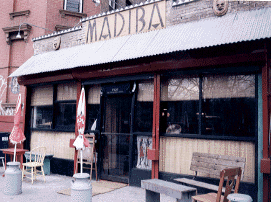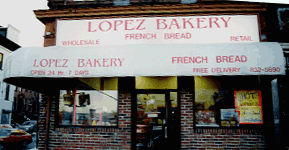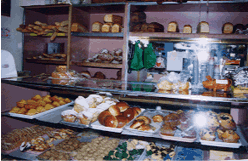

|
|
MADIBA
By Eugene J. Patron
That Madiba,
one of New York's first South African restaurants, opened in Ft. Greene
shouldn't come as a surprise. With galleries and shops like Ashanti Originals,
Simba and Moshood nearby, as well as Senegalese restaurant Keur N' Deye,
the neighborhood is becoming well known for it's African Diaspora flavor.
So much so that the local merchant association promotes  the
area as "Bogolan" after the word from Mali for mud cloth.
the
area as "Bogolan" after the word from Mali for mud cloth.
But never did I expect to find "Bunny Chow" north of the equator, let alone in Brooklyn. A street food specialty of the Indian Ocean city of Durban, bunny chow is a low-brow (but well loved) dish of curried vegetables, beans and meats poured into hollowed out white bread. You certainly never see it in glossy travel brochures for South Africa, where lobster tails and vintage cape wines grace elegant tables. Bunny chows is food of the people.
All the Fun, None of the Pretension
In the cramped kitchen at Madiba, all foods are equitable in esteem; corn meal porridge and sardines are no less valued than juicy prawns or prime meats. Likewise, both robust South African cabernets and popular local beers are served in glass jelly jars, "Shabeen" style, as the mom and pop taverns of the townships are called. In honor of the "new", South African hierarchies are definitely out of style at Madiba, which itself is an affectionate term for the father of the re-born nation: Nelson Mandela.
"South Africa has some of the most diverse cooking in the world," says owner Mark Henegan. " You have the indigenous culture, the European influences as well as East Indian. It's the rainbow cuisine."
Henegan, his wife and friends built the interior of the 30-seat restaurant themselves. The walls are crowded with Zulu beer baskets, N'debele beadwork, ostrich eggs, shelves lined with canned goods from South Africa and of course, posters honoring Mandela. A half circle, thatched N'debele (traditional hut) serves as the entrance to the rest rooms. Tables and chairs are a hodgepodge of thrift shop finds, helping to complete the authentic low-on-cash but big-on-heart feel of this transported Shabeen.
The Start of a Culinary Safari
Most of the world, as Mark points out, lives on grains, legumes and vegetables as the core of their diet. Case in point is umgqushu stambu-samp ($3), a pressed cornmeal and red kidney bean dish that is a staple of indigenous, South African home cooking. The cornmeal reminds one of pastas like spaetzle (though finer in consistency) and is infused with the mildly savory/sweet juice of the beans.
South Africa has the largest Indian population outside of India and samoosas are a favorite snack of South Africans of all ethnic backgrounds. At Madiba the samoosas ($7) come smaller than the general New York Indian restaurant variety, but make up for lost size with a juicier than average filling. Give caution to the "pickled and spicy" accompanying salad; the flecks of chili make it as hot as the Kalahari at noon. I resorted to using pieces of the thick, homemade brown bread to scoop up small tastes of the salad.
Another consideration for a starter should definitely be the Cape Malay curried mussels ($12), in which the spices gently pronounce themselves in the coconut milk curry, or the Portuguese sardines ($10), a size and world apart from their diminutive, fishy brethren stuffed into cans.
Madiba features a small but growing list of South African wines (also local beers). The 1997 Brampton Cabernet I tried by the glass ($7) had a nice, even slightly chewy, fruity body to savor.
Semi-Big Game Hunting
Eye-catching on Madiba's menu are traditional meat dishes, such as oxtail stew ($16), herbed sausages called BoErewors ($14), ostrich ($12) and a "Safari" platter ($12). South Africans love meat and even the ostrich takes like steak, though of course it comes from the biggest of birds and has very little cholesterol.
The Safari platter is a moderate sized sampling of dried meats called biltong, which Mark smokes and cures himself. You have to really like meat with the smoky taste of a campfire to get into biltong; as much a cultural icon as a food of the Dutch settlers who have called South Africa home for four centuries.
The night friends and I tried pap & veis ($15), which is corn porridge with chops, pork was being used instead of lamb. Stewed in a sauce that needed at least one spice to be bolder and step out in the forefront, the meat was nevertheless very tender and easy to separate with a fork. The thick, white corn is tasty enough, but it too could use a more robust sauce as an accompaniment.
A surprise hit is BoBotie ($14) - Cape Malay meatloaf. Nuts and fruit give the meat a sweet tinge, making one reconsider a lifetime of associating meatloaf with the dominant taste of tomato. Baked in a rectangular tin and topped with a thin souffle of egg, the dish nevertheless avoids being as heavy as many of its American cousins.
Then of course there is the bunny chow, served either with vegetables ($12) or with chicken ($15). The curry sauce could even be a tad more pronounced, if only to match the esthetic heights of the scooped out bread piled high above the half loaf containing the curried stew.
Wading into the sea, the cape seafood platter ($14) is a nice selection of mussels, octopus and calamari, all fresh and none too chewy. The stars of the platter are meaty prawns, slightly smoky from grilling but still ever so sweet.
From the Bush to Brooklyn
It's over a sampling of deserts on a cold Sunday afternoon (the Sunday brunch features a number of egg and French toast standards besides South African dishes) that Mark tells me of his vision for the Madiba. Affable and even given to suddenly leading the staff in impromptu sing-alongs, he liberally pours me a glass of Imoya, a South African brandy with a smooth and comfortable bite to the tongue.
"I want to expand Madiba into a restaurant, lounge and trading post," he says. "I'm hoping to take over the vacated deli next door. That way I can display more products and art works from South Africa to sell. Plus have live music."
Madiba is very much a family affair. Henegan's mother sends herbs and spices to him from home, and he's not shy about giving shopping lists to friends traveling to South Africa. The small desert menu (all $5) is often supplemented by pies made by Mark's wife. A regular offering is flourless chocolate cake, dense and rich enough to satisfy a basic chocolate craving. Then there's a milk tart with a consistency like flan, plus a firm pie crust. It's not very sweet, relying on a delicious array of poached pear, apple slices and thin fruit sauce to earn applauds.
Twelve years in the U.S., with six of them right here in Ft. Greene, has not lessened Henegan's ties to South Africa. His new menu for Madiba will be something of a mini-magazine about the country, including interesting facts and regular news updates. It's his way of narrowing, even if just by a little, the great distance between South Africa and the U.S.
Then again, in booming Bogolan, Africa is never that far away. To listen to Henegan gush about "a place with extremities of cultures, a kaleidoscope of color where people are creating an extraordinary society", it's possible to wonder if he's talking just about South Africa or our very own Brooklyn!
Madiba, 195 DeKalb Avenue, tel. 718 855 9190. Open for Lunch & Dinner from 6 p.m. and Sunday for Brunch, Closed on Monday; Cash Only.
For more information, check our Restaurant Listings.
NEIGHBORHOOD BAR GUIDE
Carroll Gardens, Cobble Hill
Brooklyn Heights, Boerum Hill, Park Slope
Tamales from LOPEZ BAKERY:
"More than a filling..."

When the wind chill has been 10 below for three days in a row, and the snow, sleet and ice make descending the steps to the subway platform an extreme sport, it's no surprise that our minds wander towards escaping New York and its harsh existence. But for those of us for whom food is more than just sustenance, leaving permanently is not an option. No, we've resigned ourselves to never owning a house, nor a late-model car. We are smug and self-satisfied when our relatives show us around their expansive suburban spreads, with their fenced-in yards and garages, because we know we have something they'll NEVER have -- virtually immediate access to foods not only from every nationality, but from specific regions within each country.
| Tamales from Lopez Bakery |
Mexico is a favorite mental escape during these bone-rattling months, and while Mexican food has been Americanized from Taco Bell to Chi-Chi's, New York offers a few opportunities to sample the real thing. Of course it's possible to drop a nice bill or two at some of the fancy-pants Manhattan Mexican eateries, but for someone who grew up around Mexicans, Cubans, and Central Americans - I know there's no need to spend more than a few dollars when you crave the real thing.
"Tamales are an important feature of Mexican food and date back to pre-Columbian times" according to the newly-published Oxford Companion to Food*. "The dough is made from ground corn and pure lard (which was not used of course, in pre-Columbian times.) It produced what could be described as an aromatic bun with the consistency of firm polenta".
One can't help but be grateful that a place like Brooklyn offers such an array of choices. In sampling tamales from two places on 5th Avenue, I was able to try green, red, mole, and sweet tamales from one spot, as well as pork and cheese tamales from another. I tried to pretend they weren't made with pure lard and ate them merrily.
My current favorites are the pork tamal (the singular
in Mexican) and the cheese tamal from Lopez Bakery. The cheese
tamal was very subtle and not overly cheesy with a hint of pickled jalapeno,
and the corn taste was great. The pork tamal had a little red sauce with
it and the pork inside was generous, flavorful and quite moist. I couldn't
resist topping them with a little sour cream, which made a perfect appetizer.
They're generally small enough to eat at least two at a sitting, and at
$1.25 each, quite a bargain. In addition to these little gems, Lopez also
offers excellent cheddar  rolls,
guava pastries, various cookies and desserts,
plus huge multi-grain buns for the health-conscious.
rolls,
guava pastries, various cookies and desserts,
plus huge multi-grain buns for the health-conscious.
Lopez Bakery, 423 Fifth Avenue (at 8th Street),
tel. 832-5690. Open 24 hours.
*The Oxford Companion to Food by Alan Davidson, Soun Vannithone (illustrator); Oxford University Press, 1999.
When Asian-fusion cuisine was the sexy thing in Manhattan (for about two weeks before it was "over"), we stumbled across a hipper than thou restaurant on lower Fifth Avenue. The walls were huge bleached birch panels dotted with miniature color TVs which played Japanese Anime. It was ultra-hip -- at the time. Anyway, with our cocktails they served us roasted soybeans in their pods. This instantly became my favorite snack food. When I encountered them on the menu at Osaka in Cobble Hill, I just HAD to have them, but at the price ($6.95 for an appetizer!), I wasn't going to be ordering them too often!
A little background - Edamame is the Japanese name for soybeans harvested when the seeds are immaturea nd have expanded to fill 80-90% of the pod. The seeds are rich in protein and highly nutritious. Soybeans supposedly originated in China and were introduced in Japan a little over a millennium ago. Currently, Japan is the largest commercial producer of edamame, but most of that is consumed fresh at home. They also import a large quantity of the frozen variety from Taiwan.
I later came across frozen soybean pods at a health food store in Manhattan. I scooped up as many bags as I could carry, kept one in the fridge at work and brought the rest home. I was frustrated that I had to get these in Manhattan and for months I asked the guys over at Rainbow Market if they carried them. Finally they told me to bring in an empty bag and they would see what they could do about ordering them. About a month or so later, Rainbow told me they got the soybeans, but had not been able to keep them in stock! A week later I tried again, this time with success - I went home with two precious bags of the frozen pods.
Edamame are easily prepared. If you can find the fresh variety, you can roast them and toss with a little sesame oil and tamari or just some coarse salt. For the frozen ones, you're best to just boil in some lightly salted water, or steam in the microwave. Either way, it takes only minutes. To eat, just push the seeds from the pod into your mouth with your fingers. The taste is a little bit nutty and a little bit bean-y. At 120 calories per serving and only 2 grams of fat, they're sure to be my FAVORITE snack for quite a while!
Edamame available at Rainbow Market on Court Street in Carroll
Gardens. (*Please e-mail
TOB if you find them elsewhere!)
Copyright © 1999, 2000 Taste Of Brooklyn
All Rights Reserved.